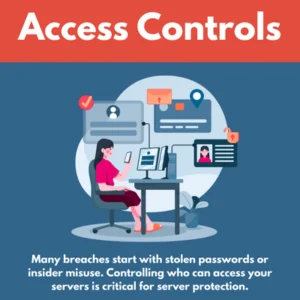Small businesses face serious cyber threats today. Many owners think they’re too small to attract hackers. This is wrong. Nearly half of all small businesses get hit by cyberattacks, showing that even the smallest company needs a solid security system in place. Worse, one in five victims goes bankrupt or closes down after an attack.
The damage from security breaches is real. Half of small businesses face 8-24 hours of server downtime after attacks. Another 50% need a full day to get back online. Applying security patches quickly and keeping up with security updates can help reduce downtime and protect customer trust.
Small companies must protect their IT systems from security threats like malware, ransomware, and DDoS attacks. This is where managed server security helps. It includes server maintenance that keeps businesses running smoothly when cyber threats strike.
What is Managed Server Security?

These providers handle setup, server configuration, monitoring, and security hardening. They apply server security best practices so your systems stay strong against attacks. This system security prevents unexpected downtime that kills productivity.
Managed servers include built-in security measures. Providers install firewall protection, intrusion detection systems, and malware protection. They run security audits and vulnerability assessments to find weak spots early. They also keep servers updated with the latest security patches.
Small businesses get enterprise-grade defenses without hiring a big IT security team. This matters because most small companies lack dedicated cybersecurity staff. Without proper server management practices, they become easy targets.
Core Security Components
Good managed server security uses multiple defense mechanisms. Here are the key parts that protect your business.
Regular Updates and Server Maintenance

Providers use automation to deploy security updates across all your servers quickly. This removes human error and speeds up fixes. Beyond software patches, they handle server maintenance tasks like checking hardware health and fixing minor server issues before they grow.
Smart server maintenance and timely patches keep your defenses strong and stable. This reduces the chance of server issues that stop your business.
Strong Network Defenses
Network security forms another key defense layer. A properly set up firewall acts like a gatekeeper. It checks all traffic coming in and going out. Good firewall controls block suspicious connections while letting business traffic through.
Managed services keep updating firewall rules as new threats appear. They use firewall protection to isolate important systems. If hackers breach one area, they can’t easily reach your other servers.
For remote workers, virtual private networks create encrypted tunnels. Remote access security keeps data safe when employees connect from outside the office. Only staff with proper credentials can reach internal systems.
If you run web applications, a web application firewall monitors web traffic. It blocks harmful attacks before they hit your servers. DDoS protection services also stop flood attacks that try to overwhelm your systems.
These server defenses shield your infrastructure from outside threats and keep services running.
Continuous Monitoring
Even with prevention systems in place, constant watching is needed. Security monitoring includes real-time oversight of your systems. Providers use monitoring tools and log management systems that watch server activity around the clock.
These tools send instant alerts when they spot unusual patterns. Security teams can see trends across your network through centralized dashboards.
Intrusion detection works like alarm systems for servers. They scan for signs of malicious activity constantly. When intrusion detection systems find threats, they alert the security team and can automatically block or contain the danger.
This catches problems early, often before they hurt your business operations.
Access Controls

Managed services set up strict security policies around user access. This includes password policies that require strong, unique passwords for all accounts. Multi-factor authentication adds an extra security layer.
The principle of least privilege means each user gets only the minimum access rights they need. Regular audits make sure privileges stay appropriate as roles change.
If a low-level account gets compromised, the attacker still can’t reach sensitive systems because those rights were never granted.
Malware Defense
Servers can get infected with malware infections just like regular computers. An infected server can corrupt data or give hackers access to your network.
Managed server security deploys malware protection tools on servers. Advanced antivirus software scans for malicious code constantly. Modern solutions use behavior analysis to catch new threats.
Security platforms like EDR systems use AI and threat intelligence to spot sneaky attack patterns. They can quickly contain infections before they spread to other servers.
These work automatically in the background, stopping threats without interrupting your business.
Incident Response and Recovery
No security is perfect. What separates strong organizations is how prepared they are when security incidents happen. Managed server security puts robust incident management and disaster recovery plans in place.
This starts with a documented incident response plan. It outlines steps to take if a breach gets detected. This includes who to notify, how to contain the issue, and how to restore systems.
Disaster recovery planning means having backups ready. Managed services include regular data backups stored securely off-site. They schedule backups based on your business needs and test restoration procedures regularly.
If a server gets hit by ransomware, the provider can quickly restore a clean version from the latest backup. This minimizes downtime and keeps critical business functions running.
Building Security Culture
People cause most cybersecurity incidents through human error. Managed security providers help build a security culture in your organization through security awareness training programs.
Employees learn to recognize phishing emails, use proper password habits, and follow cybersecurity best practices daily. Getting employees to take cybersecurity seriously is hard, but informed workers become part of your defense.
Leadership involvement sets the tone. Managed service partners work with management to develop clear security policies that everyone must follow.
When security becomes part of company culture, the whole organization gets more resilient.
The Future of Managed Security

More companies are choosing managed security services. Instead of struggling to hire scarce security talent, they get on-demand expertise from specialists.
These security technologies offer complete protection including threat detection, compliance monitoring, and incident response support. Small companies get enterprise-grade server protection at a fraction of the cost.
You access the same defenses that large corporations use. This levels the playing field.
Many industries have strict security regulations like HIPAA or PCI DSS. Good providers know compliance rules and can implement required controls. They produce audit reports and update controls as regulations change.
Data stewardship practices ensure your critical information stays accessible and safe. This includes access controls, encryption, and regular backups. Responsible data stewardship also supports compliance efforts.
Why This Matters
Investing in managed server security protects your business continuity. When your servers get professionally maintained and secured, you dramatically lower the risk of outages and data breaches.
Your team can focus on strategic work instead of fighting IT crises. The disaster recovery ensures quick recovery even in worst-case scenarios.
Business continuity depends on proactive security in today’s threat landscape. Server security best practices combined with expert management keep your servers safe and performing well.
Don’t wait for a cyber disaster to strike. Taking action now ensures your company can handle security incidents and keep serving customers.
Ready to protect your business with professional managed server security? Contact Down to Earth Technology today to learn how our comprehensive managed server service can safeguard your critical systems and ensure business continuity. Let us handle your server security while you focus on growing your business.

